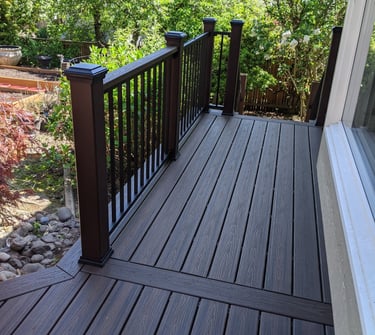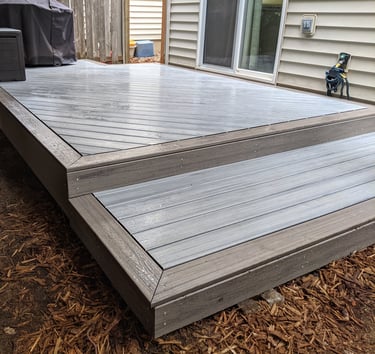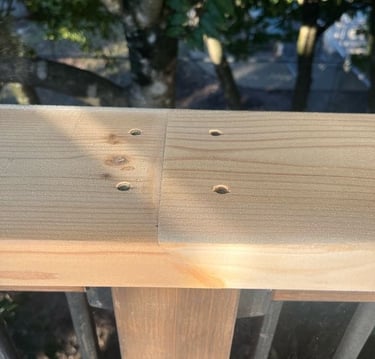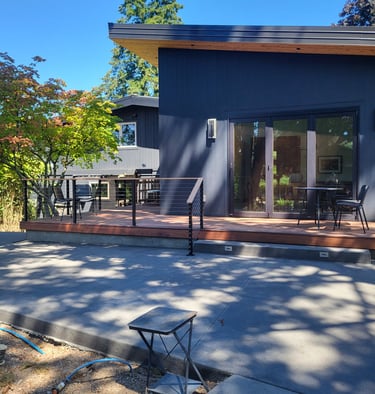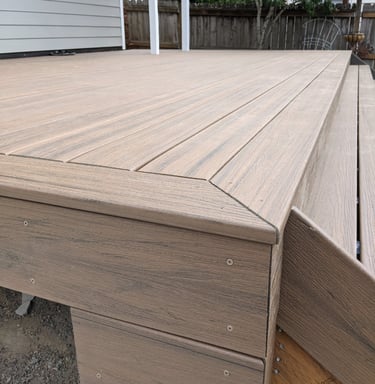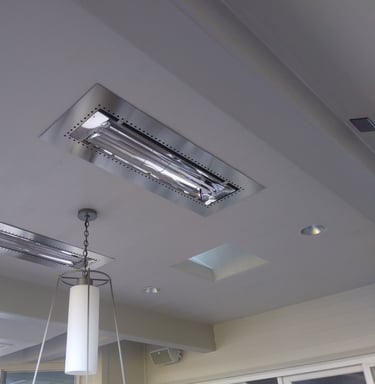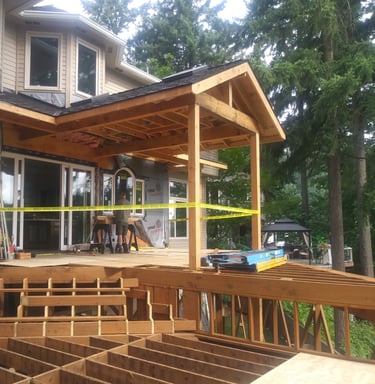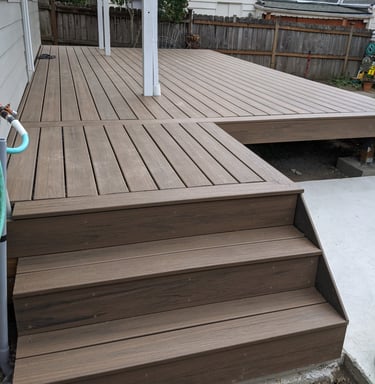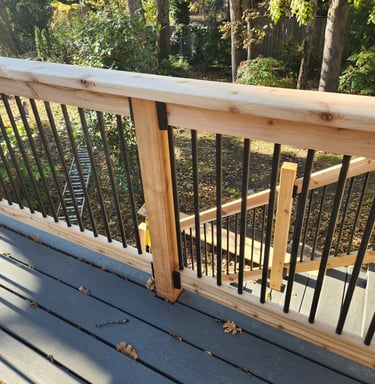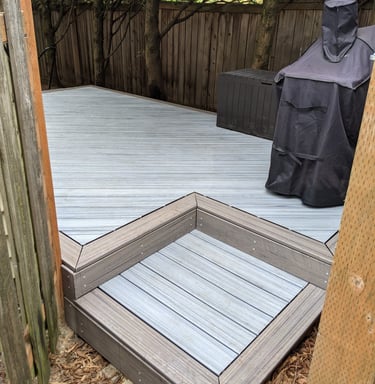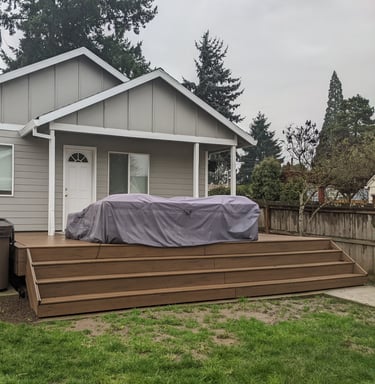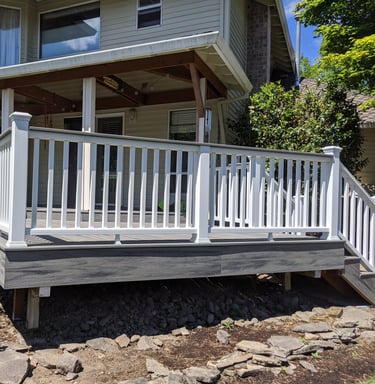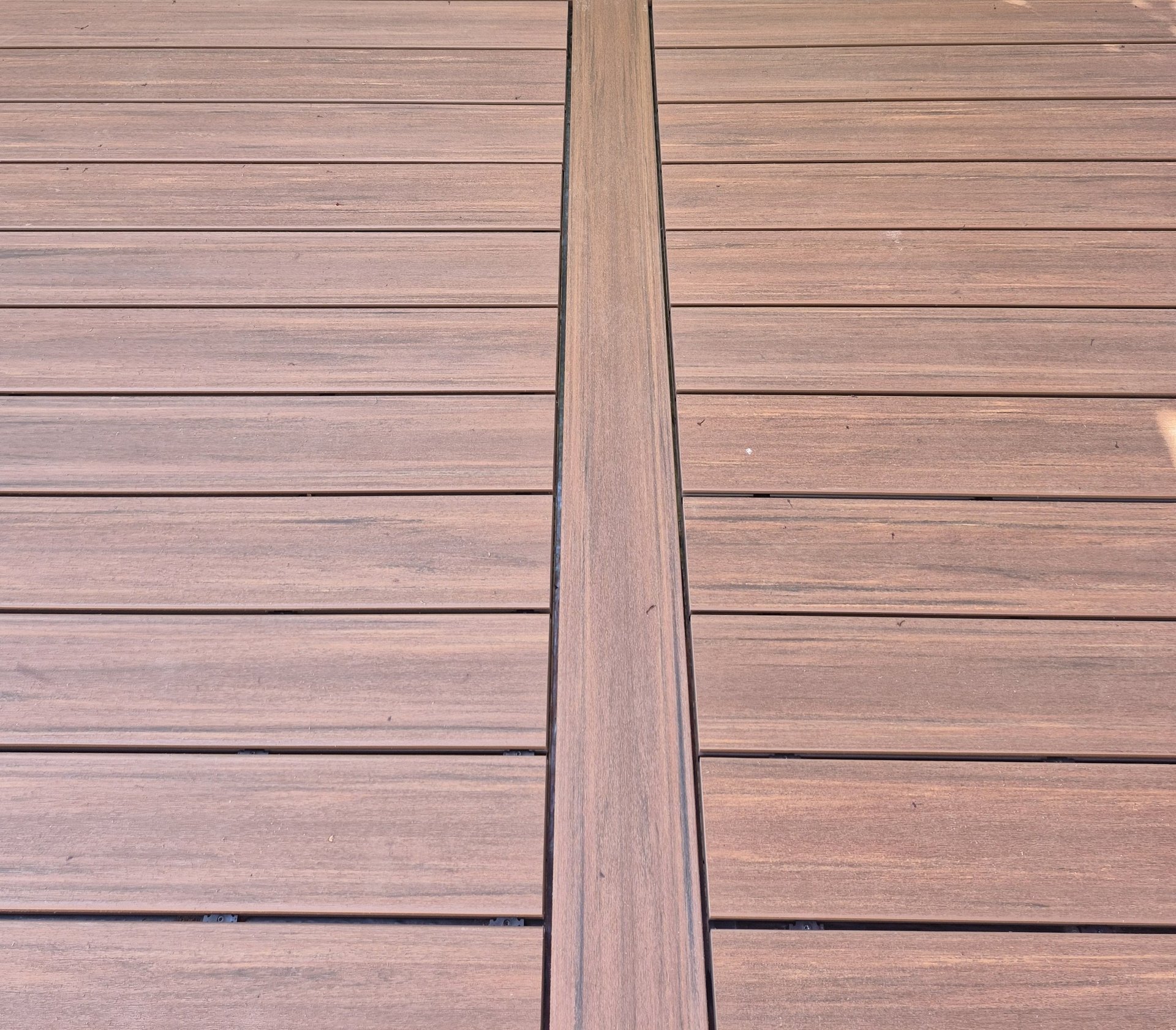
A new covered deck isn’t just an upgrade—it’s an investment in outdoor living, comfort, and unforgettable memories.
Decks and Covered Porches
A deck or covered porch is a versatile outdoor extension of the home, offering an inviting space for relaxation, dining, and entertaining. Whether open-air or sheltered with a roof, these structures create a seamless transition between indoor comfort and the natural beauty of the outdoors. Covered decks and porches provide year-round usability and protection from the elements, allowing homeowners to enjoy fresh air and outdoor living even in less-than-perfect weather. They can be designed in a wide range of styles—from simple ground-level platforms to expansive, multi-level entertainment areas complete with lighting, railings, and built-in seating. Beyond their aesthetic appeal, decks and covered porches add significant functional value, serving as comfortable gathering places for family meals, barbecues, or quiet evenings outside.
Homeowners can personalize these spaces with features such as pergolas, planters, outdoor kitchens, and ceiling fans, transforming them into true outdoor retreats. When planning a deck or covered porch, factors such as materials, maintenance, and climate should be carefully considered. Natural wood offers timeless warmth and charm but requires regular care, while composite materials deliver lasting durability with minimal upkeep. Regardless of design or material, a thoughtfully constructed deck or covered porch enhances both the enjoyment and resale value of a home, becoming an integral part of its character and daily life.

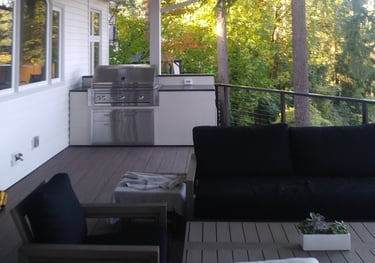
Decking Surfaces


Composite decking has become one of the most popular choices for homeowners seeking a durable, low-maintenance alternative to traditional wood decks. Made from a combination of recycled wood fibers and plastics, composite decking offers the natural look of wood without the issues of warping, splintering, or rotting. It’s designed to stand up to the elements year-round, resisting moisture, fading, and insect damage. This makes it an ideal option for those who want a beautiful, long-lasting deck that requires minimal upkeep while also being environmentally responsible—many composite boards are made using recycled and sustainable materials. Two of the most trusted names in composite decking are Trex and TimberTech. Trex is known for its high-performance, eco-friendly boards made from 95% recycled materials. Their product lines, such as Trex Transcend®, Trex Enhance®, and Trex Select®, offer a range of colors, textures, and price points to fit different styles and budgets. TimberTech, part of AZEK Building Products, also offers premium composite and PVC decking options like TimberTech AZEK®, TimberTech PRO®, and TimberTech EDGE®. These collections feature realistic wood-grain finishes, excellent durability, and industry-leading warranties that ensure long-term value and performance.
While composite decking from brands like Trex and TimberTech may have a higher initial cost compared to natural wood, the long-term savings on maintenance make it a smart investment. Homeowners can enjoy a deck that stays beautiful with little more than periodic cleaning—no sanding, staining, or sealing required. With their wide range of design options and proven track records for quality, Trex and TimberTech have set the standard for modern outdoor living, combining style, sustainability, and strength in every board
Composite Decking
Wood Decking
Wood decking has long been a classic choice for homeowners who appreciate its natural beauty, warmth, and timeless appeal. Each board carries unique grain patterns and color variations that create a rich, organic look unmatched by synthetic materials. Popular wood species for decking include pressure-treated pine, cedar, and redwood, all of which offer strength and durability suited for outdoor use. Hardwood options like ipe and mahogany are also prized for their longevity and luxurious appearance, making them ideal for high-end projects. Whether used for a cozy backyard retreat or an expansive entertainment space, wood decking provides a traditional, inviting atmosphere that blends seamlessly with the surrounding landscape. One of the main advantages of wood decking is its customizability. It can be stained, painted, or sealed in a variety of shades to match any design preference or home exterior. This flexibility allows homeowners to easily refresh their deck’s look over time or adapt it to changing styles. However, wood does require regular maintenance to preserve its appearance and structural integrity. Without proper care—such as sealing, staining, and periodic cleaning—wood can become susceptible to moisture damage, fading, and insect infestation.
Despite the upkeep, many homeowners choose wood decking for its authenticity and affordability. It typically costs less upfront than composite materials and offers a genuine, tactile experience that synthetic boards strive to replicate. With proper maintenance and quality installation, a wood deck can last for decades, providing a warm and welcoming outdoor space for family gatherings, barbecues, and everyday relaxation. For those who value craftsmanship and the beauty of natural materials, wood decking remains a timeless and rewarding investment.

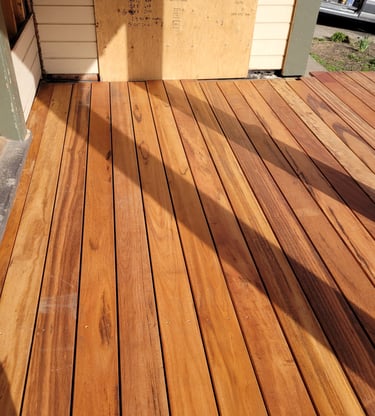
Deck Handrails
Composite Handrails


Composite handrails are a popular choice for modern decks, offering the perfect balance of style, strength, and low maintenance. Made from a blend of wood fibers and durable plastics, composite railings are designed to resist fading, cracking, and warping caused by sun exposure and moisture. They provide a sleek, consistent appearance that complements both composite and wood decking, and they’re available in a variety of colors and finishes to match any outdoor design. One of the biggest advantages of composite handrails is their longevity—unlike wood, they don’t require regular sanding, painting, or staining, and they maintain their look with just occasional cleaning. Additionally, they are splinter-free and environmentally friendly, often made from recycled materials. However, composite handrails do have a few drawbacks: they typically cost more upfront than wood, and in extremely hot weather, they can retain heat and become warm to the touch. Despite these minor cons, composite handrails remain a durable, attractive, and low-maintenance option for homeowners looking to enhance the safety and style of their deck.
Wood Handrails


Wood handrails offer a classic, natural look that adds warmth and traditional charm to any deck design. They can be crafted from a variety of woods such as pressure-treated pine, cedar, or redwood, each providing its own character, color, and durability. One of the biggest advantages of wood handrails is their customizability—they can be easily cut, shaped, and stained to match any style or aesthetic, making them a favorite among homeowners and builders who value flexibility and craftsmanship. Wood handrails are also more affordable upfront than composite options, making them appealing for those on a budget. However, they do require regular maintenance to protect against weathering, rot, and insect damage. Without proper sealing and upkeep, wood handrails can fade, crack, or splinter over time. Despite the added maintenance, many homeowners still prefer wood for its authentic appearance and timeless appeal, especially when paired with a natural wood deck.
Metal Handrails
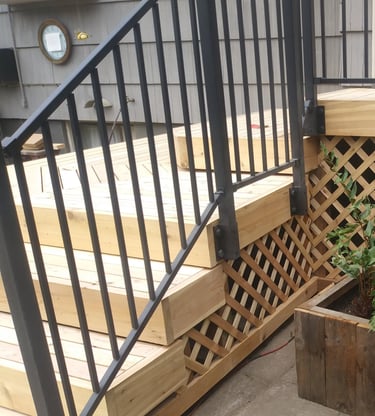

Metal handrails are a sleek, durable option that bring a modern and sophisticated touch to any deck or outdoor space. Commonly made from materials like aluminum, steel, or wrought iron, metal railings are built to withstand the elements and offer exceptional strength and longevity. One of their biggest advantages is low maintenance—unlike wood, they don’t warp, crack, or rot, and high-quality powder-coated finishes help prevent rust and corrosion. Metal handrails also provide a clean, streamlined look that pairs well with both wood and composite decking, making them a versatile design choice. However, they can be more expensive upfront than other railing materials, and darker metal finishes may become hot to the touch under direct sunlight. Additionally, some homeowners find that metal railings can feel less natural or warm compared to wood. Despite these minor drawbacks, metal handrails remain a top choice for those seeking a long-lasting, low-maintenance railing system with a contemporary aesthetic.
Cable Handrails
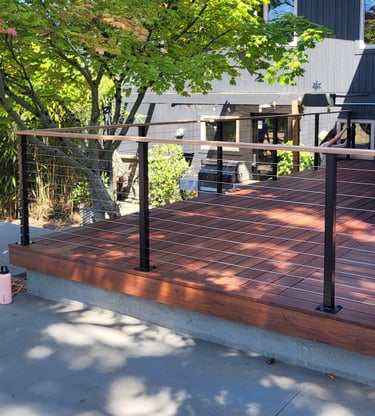

Cable handrails are a stylish and contemporary railing option that combine safety with an open, minimalist aesthetic. Typically constructed with stainless steel cables and metal or wood framing, they provide an unobstructed view—making them especially popular for decks overlooking scenic landscapes or waterfronts. One of the biggest advantages of cable handrails is their modern appearance and low maintenance; stainless steel cables resist rust and corrosion while requiring only occasional cleaning and tension adjustments. They’re also extremely durable and can complement a wide range of deck materials, from composite to natural wood. However, cable rail systems tend to have a higher upfront cost due to the specialized materials and installation requirements. Over time, the cables may need to be retightened as they naturally stretch, and some homeowners associations or local codes restrict their use for safety or aesthetic reasons. Despite these considerations, cable handrails remain a popular choice for those seeking a sleek, durable, and visually open railing system that enhances both style and visibility.
Different types of Covers


Porch covers come in a variety of styles and materials, each offering unique benefits for comfort, protection, and aesthetics. Solid roof covers, such as those made from shingles or metal panels, provide full shade and complete protection from rain, making them ideal for year-round use. Pergolas feature open-beam designs that allow partial sunlight and can be enhanced with climbing plants or retractable canopies for a natural, decorative touch. Screened-in covers or enclosed porches create a bug-free, sheltered environment that blends indoor comfort with outdoor charm. Polycarbonate or translucent covers allow natural light to filter through while blocking harmful UV rays, keeping the space bright yet cool. From traditional wood structures to modern aluminum and composite designs, porch covers can be customized to match the home’s architecture, enhance curb appeal, and extend outdoor living enjoyment throughout the seasons.
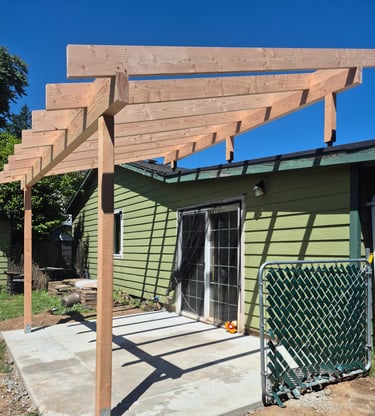

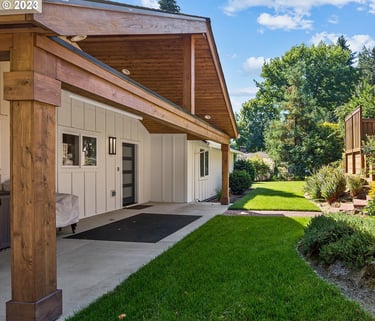

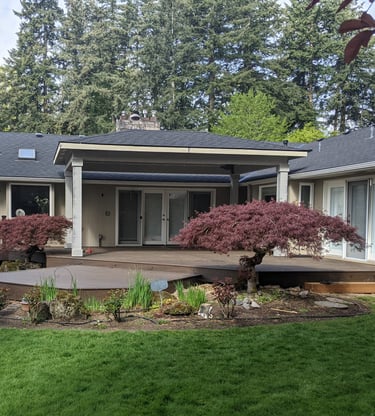

Open Pergola Style
Front Porch Cover
Free Standing Cover

Our Process
1) Initial Consultation – Contact us to schedule a complimentary consultation, where we’ll discuss your vision and provide a preliminary cost estimate.
2) Design Agreement – Once we establish a budget range, we’ll enter into a design contract to begin developing your customized deck plan.
3) Design & Engineering – After finalizing your design, we’ll coordinate with our engineering team to ensure every detail meets structural and code requirements.
4) Permitting – We’ll handle the permit application process to ensure your project complies with all local building regulations.
5) Build Agreement – With permits secured, we’ll finalize the construction contract outlining the full scope, timeline, and investment.
6) Project Start – Together, we’ll schedule a start date and bring your new outdoor space to life!
Why Choose Buswell's Home Remodeling for your Next Patio Cover or Deck.


Choosing Buswell’s Home Remodeling for your deck or covered patio build means partnering with a locally licensed, full-service remodeler that stands behind structure, design, and craftsmanship. Their team, led by Rodney and Chris, works hands-on through every phase—from conceptual design to engineering and final build—ensuring communication, accountability, and responsiveness at every turn.
Buswell’s brings deep expertise in outdoor living and structural remodeling, treating your deck not as an “add-on” but as an integral extension of your home’s style, function, and safety. Their attention to detail is frequently praised in customer testimonials for accommodating client wishes, maintaining high standards, and delivering “top-notch” results.
Furthermore, Buswell’s is a recognized contractor in the region, holding a valid license (CCB # 227334) and appearing on Portland’s FIR Contractor List. This combination of technical credibility, client-centered approach, and proven track record makes them a compelling choice for anyone seeking a dependable, high-quality deck project.



DESIGN - BUILD
Transforming homes with expert residential remodeling services.
cONTACT US
503-707-9433
© 2025. All rights reserved.
503-560-6886



